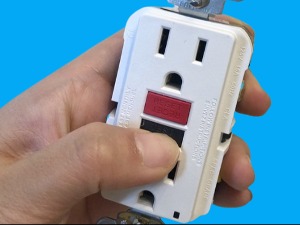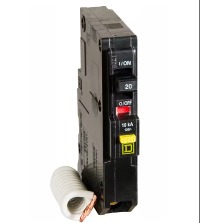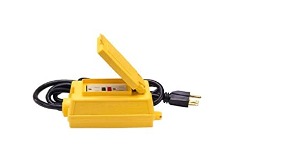
Ever since introducing the ground fault circuit interrupter (GFCI outlet) in 1973, deaths from electrical shock have reduced by 83%.
What is the ground fault circuit interrupter (GFCI outlet) used for?
A GFCI is a safety device used to protect human beings from electric shock. It is a fast-acting circuit breaker that cuts off the power supply once there are ground faults or leakage currents along the circuits.
GFCIs compare the electricity flowing into the circuit with the one coming out. If there is variation even as little as 0.005 ampere, it trips the circuit.
This protective role of the breaker makes the National Electrical Code recommend it to every homeowner.
What is a ground fault?
A ground fault (current leakage) occurs when electricity follows an unintended path to the ground. Common causes include faulty wiring and damaged cords.
Under normal conditions, currents flow through insulated wires to various electrical outlets and appliances. But when there is leakage, currents find their way to the earth.
If the stray current comes in contact with conductor or human being, electrocution occurs.
But since water is an excellent conductor of electricity, a greater chance of ground faults occurring in areas such as the bathroom and kitchen is always higher.
How do ground fault circuit interrupters (GFCI) work?
The outlet works like a circuit breaker and fuse. But while circuit breakers protect wires and electrical appliances from overload and short circuits, GFCIs protect humans from electrocution.
The outlet has a sensor that detects imbalances in flowing currents. When there is a leakage of current along the circuit even as little as 4 or 5 milliamps, the breaker trips to maintain electrical safety.
Where should I install a ground fault circuit interrupter?
You can install the outlet in all the potentially damp or wet areas such as bathrooms, basements, garages, kitchens, workshops and all the potential wet areas.
A wet environment can conduct electricity when there is ground fault, exposing you to electrical hazards but by using a gfci outlet, it will prevent it.
Related article: How to Install a GFCI Outlet in your Bathroom and Kitchen
Types of GFCI
There are three types of GFCIs, they include:
- GFCI outlets
- GFCI circuit breaker
- Portable GFCI.
GFCL outlet or receptacle

This is the most commonly used among the 3 GFCIs. Similar to a wall outlet, the receptacle is designed to protect people from electric shock.
GFCI outlets are installed in kitchens, bathrooms, and outdoors near water to offer gfci protection.
GFCI circuit breaker

Gfci beaker protects the entire electrical circuit. When you install one on your service panel box, it protects the entire circuit, electrical appliance, and other devices connected to it.
However, it is more expensive, and also harder to trace the exact place where there is ground fault.
Temporal or Portable GFCI

Portable GFCIs are frequently used on mobile applications, gardens, and in construction sites. You can also use it outdoors, on electrically powered equipment.
However, do not use it as a permanent option for a normal GFCI device.
How to install the GFCI Outlet
Installing or replacing a worn out GFCI is quite easy, just follow these steps.
Required tools and materials.
Screwdrivers (Flat and star)
Flashlight
GFI Outlet
Procedures
Turn OFF the power
Locate the circuit breaker that controls the branch circuit you want to install the outlet on and turn it OFF.
Remove the cover and the old outlet
Using your flat screwdriver, remove the outlet cover to expose the receptacle.
Use your star screwdriver to lose it and pull it out from the electrical box.
Inspect the connection to see where each wire goes
Disconnect the wires and connect them to the new receptacle
The wiring system usually comprises 3 wires:
- We usually connect the black or hot wire to the brass terminal
- White or neutral wire connected to silver terminal
- Green or copper wire connected to the green screw. This serves as the ground wire.
Connect the wires to the respective terminals and secure them with a wire nut.
Put the GFCI plug back in the outlet box and cover it with a wall plate
Once you are through with the connection, put back the outlet and secure it with screws before covering it with a wall plate.
Benefits of having a GFCI Outlet in your home
Apart from the ground fault protection you gain from this outlet, there are still other benefits. They include:
1. Protection from electric shock
GFCIs protect humans from electric shock by tripping off the current when there is a loss of current.
2. Prevent fire outbreaks
While the primary role of GFCI is to protect you from ground faults, it also saves our homes from fire outbreaks which may arise from the current leakage and power surge.
3. Save our appliances from damage
If there is a continuous leakage of current from a cracked insulation, it may affect or damage any appliance close to it.
But if you have a gfci receptacle in your house, it will take control of all the faulty currents that may cause damage.
How to self-test your gfci outlet.
Testing your GFCI outlets is easy, you can do it yourself. Experts recommend testing it once every month and replacing the outlet every decade.
To test it, look at the face of the outlet. Between the slots where you plug in cords, lie two rectangular buttons labeled ‘TEST’ and ‘RESET’.
Press the test button to shut off the power. Confirm if the outlet is OFF, using your multimeter or by plugging in a device in the slot. Once you confirm it, press the reset button to restore the current to it.
Difference between AFCI outlet and GFCI
Arc-fault circuit interrupters (AFCI) and ground-fault circuit interrupters (GFCI) are both electrical devices that protect against fire and electric shock.
The law requires that we install them in every new building. While they do almost the same work, their difference lies in the area they protect.
AFCI detects electrical faults within your circuit, which may damage your wiring system and appliances. (They protect wiring systems and appliances).
Meanwhile, the GFCI protects human beings from electrical shock.
Related articles